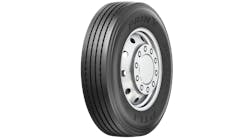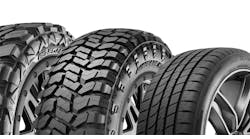Are commercial tire dealers and their fleet customers frequently on the same page? In the interest of both parties, Modern Tire Dealer and its sister publication, Heavy Duty Trucking, tried to find out.
MTD and HDT, with the help of Firebox Research & Strategy, combined their resources in order to present an unfiltered, unbiased look at how tire dealers and fleet users view the products and services available to them as they relate to truck tires.
The report presents the summary findings of a comprehensive Web survey that received demographically valid responses from across the U.S. and Canada.
“By looking deeply at the buying, selling and servicing of truck tires, and the maintenance support surrounding them, we believe the industry will gain better insights into the process,” says MTD Publisher Greg Smith.
Respondents from tire dealerships and truck stops completed the MTD survey. The majority of respondents to the HDT survey work in a headquarters location for a regional private fleet servicing the general freight or construction industries.
He said, she said
When asked to rank the industry issues facing the commercial tire industry, tire dealers cited fleet operating costs and tread life as one-two in order of importance.
“As operating costs rise, fleets are looking for more creative ways to save money,” said one dealer. “Tires being one of their largest expenses are the first area they look to save money. This causes a short-term solution (i.e., the purchase of low-cost imports) and creates a long-term issue from both a safety and budgetary standpoint.”
Roadside service, “the need for tire dealers to offer mechanical services,” and “tire air pressure on trucks” are also issues high on the list.
“Air pressure is the biggest killer of tires,” said one dealer. “PSI still remains the number one concern in all fleets,” said another.
From the fleet perspective, the most cited issues facing the commercial tire industry are fleet operating costs, fuel economy (middle of the pack among tire dealers), tread life and tire air pressure on trucks. Seemingly in contrast, despite their emphasis on fuel economy, most fleets consider the Environmental Protection Agency’s SmartWay program as being of low importance. To 44% of the fleets with 100 or more trucks, however, SmartWay is very important.
“All parts, including tires, are on the rise as far as cost,” said one fleet owner. “Profit margins are small, so every dollar you can save means the better my company does as a whole.”
“Costs continue to rise even when fuel prices decline. They should correlate,” said another fleet owner.
Whereas fleet owners do not believe the need for commercial tire dealers to offer mechanical services is an issue, some tire dealers see it as a necessity.
“I believe service will start to become something local small fleets will need as diagnostic and specialty tools become more expensive,” said one dealer.
“Major manufacturers are trying to dictate profit margins for the dealers, and this is causing us to look for additional revenue sources,” said another.
Inventory management
All tire dealer respondents were asked to indicate 1) which brands they carried in their dealerships, and 2) what brand was their primary brand. They were also asked to rank the brands based on quality.
Overall, Bridgestone, Firestone, Continental and Goodyear are not only the brands most commonly carried by tire dealers, but also the brands most commonly cited as the dealer’s primary brand.
Dealer brand Carried by Primary
Bridgestone 48% 38%
Firestone 48% 34%
Continental 46% 31%
Goodyear 45% 30%
General and Michelin tied for fifth, with 42% of the dealers carrying them. General was labeled a primary brand by 25% of the dealers, Michelin by 20%.
Fleets were asked to indicate which brands they used in their fleet operation, and which were their primary brands. The rankings were slightly different.
Fleet brand Used by Primary
Bridgestone 71% 25%
Goodyear 60% 20%
BFGoodrich 54% 9%
Michelin 54% 33%
Close behind Michelin in terms of fleet usage was Firestone at 53%, followed by General (46%), Continental (45%) and Yokohama (41%).
To see 2016 Replacement Medium/Heavy Truck Tire Brand Shares, click here.
Tire brand quality
How do fleets view brand quality? Both similarly and differently than tire dealers.
Among fleet owners, the brand with the highest quality rating is Michelin, with an average (mean) quality rating of 8.9 on a scale of 1 (“very low quality”) to 10 (“exceptional quality”). The size of the fleet made no difference; whether the fleet owned one to nine trucks (8.91), 10 to 24 (8.55), 25 to 99 (8.85) or 100 or more (9.57), Michelin was always the highest-rated brand.
In second place is Bridgestone at 8.1 (and runner-up in all four of the fleet size categories), followed by Goodyear at 7.6, Yokohama at 7.4, Firestone at 7.3 and Continental at 7.2.
Rounding out the top 15 brands based on fleet rankings are BFGoodrich, Toyo, General, Dunlop, Ceat, Kelly, Hankook, Sumitomo and Dayton.
Michelin, Bridgestone and Goodyear, in that order, are also the top brands among the tire dealers ranking quality. After that, however, there are distinct differences between the dealers and the fleets.
Keep in mind quality does not refer to value, which is why some of the brands on the list differ from actual replacement truck tire market share.
In general, fleet personnel rated the technical support provided by tire manufacturers at 7.38 out of 10. Personnel from the larger fleets — those with 25 or more trucks or tractors — typically rated the manufacturers higher, while respondents from smaller fleets rated them lower.
On the dealer side, the mean rating for tire manufacturer support to single facilities is 6.48 out of 10, with 6% of them describing the support as “exceptionally good.” Dealers with multiple facilities rated supplier support at 6.85, with 3% giving the suppliers a perfect 10.
To see our Tire Brand Quality chart, click here.
Fleet perception of retreaded tires
Not surprisingly, when rating the retreadability of truck tires, fleets ranked the top six brands in the same order as they did with tire brand quality.
On a scale of 1 (“very poor”) to 10 (“exceptionally retreadable”), Michelin scored 8.77, again finishing first in all fleet size categories. Bridgestone was second, followed by Goodyear, Yokohama, Firestone and Continental. Rounding out the top 15 are General, BFGoodrich, Toyo, Dunlop, Kelly, Sumitomo, Falken, Hankook and Dayton.
Here are the overall quality scores for retreaded truck tire brands in the eyes of the fleets:
Michelin: 8.77 Bridgestone: 8.21
Goodyear: 7.90 Yokohama: 7.45
Firestone: 7.43 Continental: 7.18
General: 6.97 BFGoodrich: 6.85
Toyo: 6.71 Dunlop: 6.68
Kelly: 6.57 Sumitomo: 6.30
Falken: 6.19 Hankook: 6.12
Dayton: 5.91 Kumho: 5.67
Dynatrac: 5.47 Hercules: 5.14
In terms of preferred retreading processes, the Bandag method was specified by 22% of the fleet respondents, followed by Michelin Retread Technologies at 18%. Goodyear Tire & Rubber Co., which offers precure, mold cure and Unicircle processes, was third at 9%. The Oliver precure process was specified by 5% of the fleets. The Marangoni Ringtread and ContiLifeCycle processes were fifth and sixth, respectively.
The larger the fleet, the more it is likely to use retreads (although only one in six fleets purchase casings). Respondents from fleets with 100 or more trucks said they all use retreads; for Class 7 and 8 vehicles, they use more than twice as many retreaded truck tires as they do new tires. Eighty-three percent of the fleets with 25 to 99 trucks use retreads.
Close to one-third of the fleets with less than 25 trucks don’t use retreads.
The majority of respondents, including 10% of the largest fleets, believe they can retread a tire only once. One in four believe a truck tire can be retreaded twice.
Balancing act
Mounting and balancing tires is not a unique service among commercial tire dealers with multiple facilities. In 100% of their responses, they have mounting and balancing equipment in their shops. The percentage is 75% for dealers with single locations.
On the fleet side overall, 45% either own or lease their own mounting and balancing equipment (for fleets with 25 to 99 trucks, its 70%).
The opportunity to offer fleets in-tire balancing is even greater than mounting and balancing the tires for them in the traditional way. While more than three-quarters of the dealers offer the service (89% for dealers with multiple locations), only 30% of the fleets use them. Smaller fleets are slightly more likely to use them versus larger fleets.
Refinished business
Steel wheels account for 44% of the average fleet’s wheel inventory. It ranges from 32% for a fleet with one to nine trucks to 58% for a fleet with 100 or more trucks.
The main reason the majority of fleets choose steel wheels over aluminum is the lower cost option. Wheel refinishing can keep them on the road even longer.
According to the Occupational Safety and Health Administration (OSHA), corroded wheels have to be removed from service and marked as “unserviceable.” Wheel refinishing can remove old coatings and rust, and coat the wheel to help slow future corrosion.
Close to half (49%) of the fleets have their steel wheels refinished, with the primary commercial tire dealer performing the service 51% of the time. However, the larger the fleet, the more dependent it is on others, particularly tire dealers, to perform the refinishing. For example, none of the fleets with 100 or more trucks refinish their own wheels, with their primary tire dealers accounting for two-thirds of them. Half of the fleets with nine or less trucks refinish their own wheels.
Additional opportunities
There are other products and services tire dealers can offer fleets to help them manage operating costs. According to fleet respondents,
- 38% use tire pressure monitoring systems;
- 7% use tire sealants;
- 24% own their own roadside service vehicles;
- 24% use wide-base tires (it’s 40% for fleets with 25 to 99 trucks).
The last bullet point is a little misleading. Even among the fleets that use wide-base tires, only 11% of their trucks are equipped with them (19% for fleets with 25 to 99 trucks).
Fleet profile
The average fleet runs 113 trucks, 78 tractors and 125 trailers, though the median was six trucks, seven tractors and 12 trailers, suggesting that the overall market is comprised primarily of smaller fleet operators.
Commercial tire dealer profile
The typical commercial tire dealer services mostly private fleets versus for hire fleets. Here is the business breakout for dealers with single facilities versus multiple facilities.
Type of fleet Single Multiple Average
For hire 40% 53% 46%
Private 85% 71% 78%
On average, the percent of sales to owner-operators is 52% for dealers with single facilities and 44% for dealers with multiple facilities.
Commercial truck tires represent 46% of the average dealer’s sales. The average number of tires sold by dealers to fleets is 340 per month – 45 and 553 for single — and multiple-store dealerships, respectively.
To see the SmartWay-verified tire list for 2016, click here.




